Day: April 12, 2011
Hand-Drawn
Just for the record, I saw Certified Copy at last year’s Cannes Film Festival and took a couple of hours to review it, and then I took another hour to respond to a putdown written by Glenn Kenny.
Plot Octopus
Take five minutes and read Lea Shafer‘s Amazon.com review of David Mitchell‘s “Cloud Atlas,” which will be co-directed by Andy and Lana Wachowski and Tom Tykwer for Warner Bros, with Tom Hanks playing one of the lead roles.
The book tells six stories about six connected characters in different places and eras, so obviously the Wachowskis and Tykwer are going to divvy them up. Will they go 3 for each or 4 for the Wachowskis and 2 for Tykwer? But consider the entire package and tell me this movie isn’t going to be one fascinating six-legged grizzly bear of a movie.
“‘Cloud Atlas’ has aspects of the dystopian future scenarios that I so loved in The ‘Handmaid’s Tale’, ‘Dune’ and ‘The Sparrow’ coupled with recent past and long-past stories,” Shafer writes. “It addresses basic questions of where we are going as a species, following one soul reincarnated through six lives. That soul is on a trajectory that traces the basic human desire for domination, the often-myopic thinking of the powerful, and the fate of the powerless. It is on a grand scale, beautifully told, and quite enthralling.
“The structure is what had me hooked to start — it is a mirror of itself. Rough breakdown: The first and twelfth chapters are ‘The Pacific Journal of Adam Ewing,’ a story of subterfuge, gullibility, and poison on a ship bound from the South Seas to London.
“Second and tenth chapters are epistolary, taking place in 1939 through the correspondence of Frobisher — a bit of a cad and scammer — to his friend Sixsmith. Frobisher is a brilliant musician but the family shame, in the process of writing his great masterpiece while apprenticing under a syphilitic genius composer.
“Third and ninth chapters follow the efforts of investigative journalist Luisa Rey to uncover serious evil at a soon-to-be opened nuclear facility in the mid-70s. One of her primary sources in the mystery is Sixsmith, Frobisher’s correspondent from the last chapter, but now 35 years older.
“Fourth and eighth chapters are the disturbing and frequently funny tales of Timothy Cavendish, a bumbling, arrogant, failure of a publisher in London during roughly our current times, maybe a little later.
“Fifth and seventh chapter are my favorites — here Mitchell hits the sci-fi, dystopian future part with full gusto. Sonmi-451 is a human clone of sorts, grown in a womb tank (like all ‘fabricants,’ as they are called) and born into service to Papa Song Company. The world as we read about it is governed and shaped around corporate structures and the economy is based on the slave labor of these fabricants.
“This chapter is her testimony about her ascension from fabricant to full human thinking and feeling. She observes the world outside Papa Song restaurant and ventures into the broader culture (a scary place, indeed).
“I don’t do these chapters justice. Sonmi~451 weaves a wonderful tale about this future world, using neologisms and appropriated words that make perfect sense based on how we are using language now. The links and connections to life in the 21st century make it compelling.
“The peak chapter, ‘Sloosha’s Crossin’ an’ Ev’rythin’ After,” describes a fallen world, one that has collapsed in on itself leaving the vast majority of humans in a new Dark Age where violence and predatory actions are the way of those who want to live very long. The strong dominate and destroy the weak. The protagonist, a goat herder, refers to the ‘civ’lized days before the fall when people was ler’nd.’ It’s written in this dialect and he tells a hard-wrought tale of lawless times.
“But it’s all believable. Mitchell never stretches his story in any part of the book beyond what we can imagine. He begins with a tale of dishonesty in the 1800s and spins it into the future, following some of our baser instincts to their logical, if stunning and frightening, conclusion.
“This book is complicated and ambitious–it’s a little over 500 pages of teeny, tiny print and plot lines that crisscross over chapters, lives, and hundreds, maybe thousands, of years.
“The reincarnation theme is only hinted at in the vaguest of terms. It’s not even a central part of the book, but it does weave the narrative thread from character to character. I can’t begin to fathom how many Post-it notes and spreadsheets it took Mitchell to keep track of all this.
“‘Cloud Atlas’ was the most thought-provoking novel I’ve read in years and I found myself meditating on the lives of the characters long after I’d put it down and moved onto something else. [An] extraordinary work.”
Figure It Out
Fact #1: Joe Wright‘s Hanna came in second last weekend behind Hop, but it was the most popular new film with $12.4 million, edging out out third-place Arthur by $200,000.
Fact #2: CinemaScore polling gave Hanna a C-plus (which is a fairly shitty grade as CinemaScore respondents tend to err on the side of politeness and noblesse oblige) and Arthur a B.
Fact #3: Hanna‘s Saturday-to-Sunday earnings dropped 37% for a $3.2 million haul while Arthur fell 46% over the same two-day period, bringing in $2.7 million on Sunday.
How does that work exactly? What kind of Harvard Law School graduate do you have to be to give the obviously high-throttle, high-style and super-confident Hanna a C-plus (or roughly a grade in the mid to high 70s, to go by high-school testing standards) while giving the tepid Arthur a mid-range B (which means about an 87)? And how do those sentiments turn around and result in Hanna earning $500,000 more than Arthur on Sunday?
What is it exactly that people are finding offensive about Hanna? Obviously a significant number of moviegoers have a problem with it. But regarding what?
Snow White in Quotes
I meant to comment about Sunday’s duelling Snow White movie ‘Power Grid” posting by TheWrap‘s Josh Weinstein, but I’m only just getting around to it now. If I was Hollywood’s moral-aesthetic emperor with absolute power and a terrible swift sword with no responsibility to deliver profits, I would shut both of these projects down immediately without the slightest hesitation, and I would order the supporters and financiers of these projects at Universal and Relativity to take two-year nature sabbaticals in Africa or Antarctica, or go to Japan and help with the radioactive clean-up.
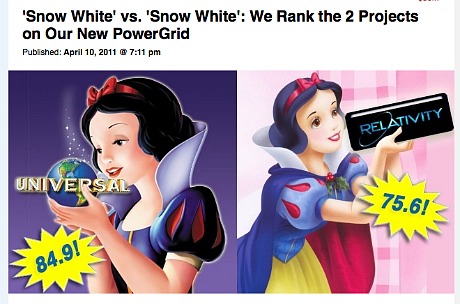
Why? Because the idea of not one but two Snow White movies with big stars coming out in 2012 is completely sickening. Because they’re only being made because adaptations of games and comic books and fairy tales (plus sequels) are pretty much the only things that families and under-30s are willing to pay to see on opening weekends, and are therefore the only things being green-lighted by the studios these days. Because they’re the latest metaphors for the all-but-total-collapse of courage and imagination and creative pizazz in Hollywood production circles. Because they’re both going to be movie-movies that will carpet-bomb viewers with over-acting “in quotes” (a la Johnny Depp‘s Mad Hatter in Alice in Wonderland). And, I’m guessing, because they’re going to be made without the slightest trace of emotional sincerity. Air quotes, air quotes, air quotes all the way.
A Lotta French
Last night HE attended the lavish hoo-hah opening of the City of Light City of Angels (COLCOA) Film Festival at West Hollywood’s DGA building. Elegant surroundings, cool-cat supporters (including directors Michael Mann and Larry Kasdan), great champagne, etc. I’ll be dropping into several screenings later this week because I find French films enormously soothing and transporting, and because they tend to be more emotionally supple and mature than American films.
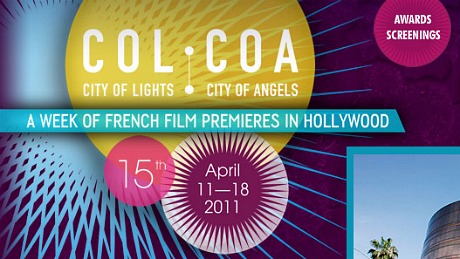
Monday, 4.11, 8:45 pm.

DGA lobby — Monday, 4.11, 8:45 pm.
Usually the opening-night attraction at any festival is on the bland and underwhelming side. So I was somewhat surprised to discover that last night’s film, Phillipe Le Guay‘s Service Entrance with Fabrice Luchini and Natalia Verbeke, was an exception to the rule.
Set in the early ’60s Paris, it’s about a highly regulated financial adviser (Luchini) who falls for a young Spanish maid (Verbeke) that he and his wife have recently hired, and who lives on the cruddy top floor with several other Spanish maids working for neighbors. I’m calling it a smooth and concisely written and generally agreeable light dramedy — the kind of French film that isn’t usually exported to the U.S. because of its unassertive, mild-mannered nature but works very nicely according to its own mood and pacing.
Service Entrance opened two moths ago in France and has reportedly done well. It’ll probably never open here, although it should.
I’ll be seeing a few other COLCOA films this week — Bertrand Blier‘s The Clink of Ice, Pierre Salvadori‘s Beautiful Lies, Katell Quillevere‘s Love Like Poison, Fabienne Berthaud‘s Lily Sometimes and Romain Gavras‘s Our Day Will Come, among others.
Every time I see that COLCOA acronym it his me the wrong way. Why decide on a name for a film festival that looks like a hybrid of cocoa and coca-cola? Why not just call it the annual Los Angeles French Film Festival?
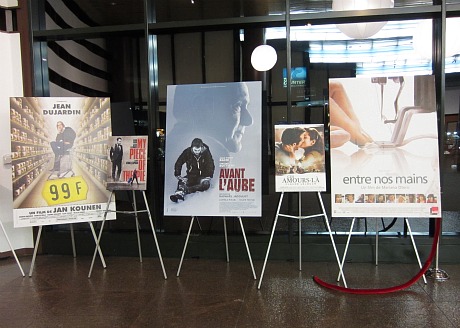
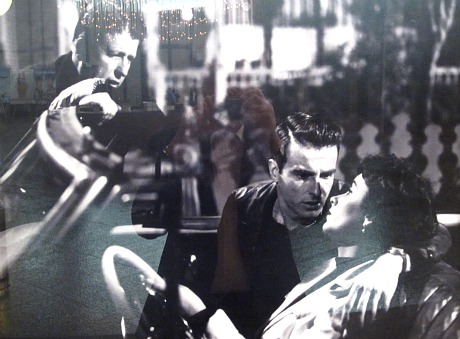
Mounted DGA-lobby still of George Stevens directing Montgomery Clift and Elizabeth Taylor in A Place in the Sun. All three are dead now.
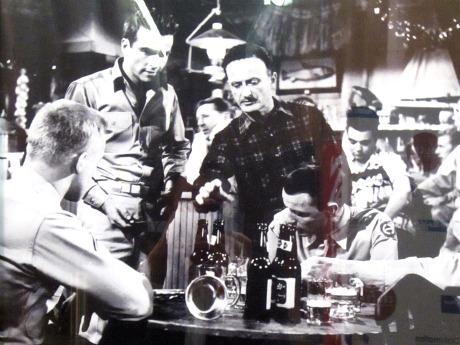
Fred Zinneman directing Montgomery Clift and Frank Sinatra during bar-confrontation scene in From Here To Eternity.
Jackson Embracing 48 fps
The 48 frame-per-second Director’s Club now numbers three — James Cameron, Douglas Trumbull and Peter Jackson. Late yesterday Jackson explained on his Facebook page why he’s shooting The Hobbit at 48 fps.
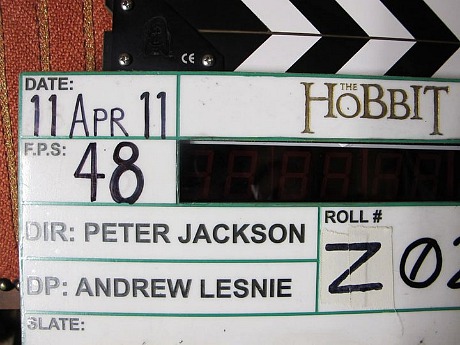
This is obviously a digital technology deal when it comes to exhibition (i.e., theatres that are still using reel-to-reel analog projection could never project at 48 fps) but what would this mean percentage-wise? How many top-tier urban theatres will likely show The Hobbit, Avatar 2 & 3 and Trumbull’s untitled latest in this format? And what about those behind-the-times houses in the boonies? Will Cameron-Trumbull-Jackson be shooting traditional 24 fps versions of their films to accomodate this sector? Because Jackson is clearly uncertain in his post about whether the 48 fps will be an exhibition reality by the time The Hobbit opens.
“We are hopeful that there will be enough theaters capable of projecting 48 fps by the time The Hobbit comes out where we can seriously explore [this] possibility with Warner Bros.,” Jackson writes. “However, while it’s predicted that there may be over 10,000 screens capable of projecting The Hobbit at 48 fps by our release date in Dec. 2012, we don’t yet know what the reality will be. It is a situation we will all be monitoring carefully. I see it as a way of future-proofing The Hobbit. Take it from me — if we do release in 48 fps, those are the cinemas you should watch the movie in. It will look terrific!”
You know what’ll be cool? When a director announces he’s using 48 fps on a modestly-scaled, dialogue-driven film that doesn’t need it. Because extra-clean visual clarity is beautiful and enjoyable in and of itself — you don’t 3D fairies and hobgoblins and hammerhead dinosaurs. I remember saying 28 years ago that a truly hip and beautiful use for Trumbull’s Showcan process (60 fps) would have been the film version of David Jones and Harold Pinter‘s Betrayal. I’ve also expressed support for Baz Luhrman‘s proposed 3D version of The Great Gatsby, precisely because it’s unnecessary.
Betrayal, by the way, is still unavailable on DVD/Bluray, possibly due to some thoughtless and/or obstinate descendant of producer Sam Spiegel, whose estate, I’ve been told, owns the rights.
Williams vs. Brooklyn Cool
So a network anchorman openly deriding what he sees as the foo-foo pretensions of Brooklyn hipster culture needs to be processed in quotes? Because the Brian Williams script, obviously, is basically saying that X-factor Brooklynites haven’t a culturally sincere bone in their bodies, and that they see and process everything in ironic terms.
You know what? Too much friggin’ stuff is in quotes nowadays. There’s something to be said for the old John Wayne-James Cagney ethos of planting your feet, looking the other guy in the eye and telling the fucking truth without any of that “do you get how I’m speaking ironically?” crap.
In Wayne and Cagney’s view, Brooklyn X-factor types have created a culture that may have began in the ’90s with their inability to afford Manhattan rents, but is primarily about (a) small businesses with an organic, cool-cat, anti-corporate aesthetic, (b) relatively few corporate chain stores except in some high-density areas where corporate-funded businesses are long established, (c) scraps of garbage on the sidewalks and (d) relatively few tourists. What’s not to like except for the stunningly ugly Hispanic neighborhoods (like Graham Avenue from Montrose Ave. south to Broadway/Flushing)?
You know what’s really, really nice about being back in West Hollywood? No garbage at all on the sidewalks. Not a single scrap. I wonder why that is. Any theories, Glenn Kenny?
